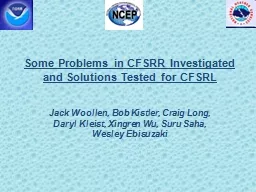

Jack Woollen Bob Kistler Craig Long Daryl Kleist Xingren Wu Suru Saha Wesley Ebisuzaki Following an intense effort to complete the CFSRR reanalysis for 19792010 which contained many new features and had to be conducted in a very strict timeframe problems became ev ID: 786946
Download The PPT/PDF document "Some Problems in CFSRR Investigated and ..." is the property of its rightful owner. Permission is granted to download and print the materials on this web site for personal, non-commercial use only, and to display it on your personal computer provided you do not modify the materials and that you retain all copyright notices contained in the materials. By downloading content from our website, you accept the terms of this agreement.
Slide1
Some Problems in CFSRR Investigated and Solutions Tested for CFSRLJack Woollen, Bob Kistler, Craig Long,Daryl Kleist, Xingren Wu, Suru Saha, Wesley Ebisuzaki
Slide2Following an intense effort to complete the CFSRR reanalysis for 1979-2010, which contained many new features, and had to be conducted in a very strict timeframe, problems became evident in the results. Several were serious enough that a lower resolution rerun of the CFSRR (named the CFSRL), was proposed to address and correct them, and to run through the period 1948 to the present as a replacement for the R1 product. The presentation describes our experience addressing four problems affecting the atmospheric part of the CFSRR, pre-1998, and how they are to resolved in the CFSRL system. Introduction
Slide3We looked at 4 issues:SSU bias correctionAsian radiosonde radiation correctionsTropical tropospheric cold biasQBO wind analysis
Slide4We accomplished 3 objectives:Devise and/or install a solution for each issueRun 8 years of “CFSRL” testing(1979-1986) for validation Run 2 additional 2-year experiments to further develop the QBO analysis (82-83, 98-99)
Slide5Issue #1 Extreme Stratospheric Temperature Variations With Jumps At Processing Stream Boundaries
Slide6Slide7Prior to 1998 the SSU assimilation is implicated, especially bias correction of channel 3Model warm bias feeds into SSU bias correction and heats up the stratosphere until a stream (or satellite) boundary occurs when the bias correction resets…
Slide8Slide9Problem Propogates DownwardGlitches in 50mb raob temp bias at boundaries
Slide10With Ch3 bias correction off Ch1&2 look better too So turn off the SSU channel 3 bias correctionDee et al, “Importance Of Satellites For Stratospheric Data Assimilation”, 2007
Slide11Issue #2CFSRR Radiosonde Radiation Correction (RC)Four separate operational tables used Creates discontinuities in temp analysisInteract with
variational satellite bias correctionsHighlights the need to use a continuous radiosonde correction in CFSRL, as in
ERA, JRA, MERRA, etc.
Slide12Large change in (o-a) bias wrt radiosondes at 200mb over Asia in 1992
Slide13Asia Region
Slide14CFSRR R2 CFSRL RC table change in 1992 explains the jumpRCOB-ANRCOB-OB
Slide15CFSRR R2 CFSRL But CFSR basically ignores the uncorrected radiosonde prior to 1992
Slide16CFSRR R2 CFSRL Results different from R2 due to resolution andVBC’d radiances vs retrievals
Slide17CFSRR R2 CFSRL Test of a simple adaptive correction for CFSRLNeed to apply RAOBCORE type corrections also
Slide18Improved Fits To Analysis And Forecast
Slide19Issue #3 Significant differences from other reanalysesIn tropical tropospheric temperature
Slide20CFSRR1/R2
Slide21CFSRR Cold bias compared to radiosondes
20N-20S
Slide22CFSRR didn’t draw for the radiosonde temperature data in the tropics_________________________Solution: adjust the GSI structure functions to increase the forecast variance in the tropical region, top to bottom__________________________Analysis fits improved and large biases disappeared
Slide23Analysis fits improved____________________Forecast fits not so muchDiagram from Fanglin Yang
CFSRL (solid lines) versus CFSRR (dotted lines)AN FC
Slide24Radiation correction not very largePoor initial fit in CFSRR gets better over time withobservation density increaseCFSRR R2 CFSRL RCOB-ANRCOB-OB
Slide25CFSR analyzed sat radiance – R2 analyzed retrievalsMust explain the opposite biasesCFSRR R2 CFSRL
Slide26New Radiosonde RC seems not to play much of a role in the CFSRL improvement hereCFSRR R2 CFSRL
Slide27Improvements From Tropical Structure Function Changes
Slide28Issue #4QBO Wind Reversals Not Captured WellDiscovered too late to fix in CFSRRCaught by surprise – not a problem in R1 or R2Bogus ERA40 winds into CFSR QBO region Jul1981 - Dec1998
Slide29Slide30CFSR captured one transition (weakly)before bogusing began
CFSR QBO improves after 1998So
bogusing ended
Slide31Problem seems to be due to overly narrow tropical FE structure function pre-1998 R2CFSR
Single u component impact
Slide32U-comp wind Singapore raob vs reanalysis 10mbOriginal SF Inflated variance (SF*4)
Inflated variance appears to solve problem in test run starting in May1994
Slide33However, zonal wind compared to Singapore obshows the prx (SF*4) system still not capturing the wind phase shifts sufficiently in early 1980’sLarge bias in 1982 easterly phase shift
Slide34Need additional work to fix the QBO Is the SSU data interfering with the QBO wind analysis? Damp the effect of SSU channels by raising ob errors. How else can the impact of the data be increased?Assimilate synoptic observations all day.It turned out both of these measures had a similar positive effect on the QBO analysis,but each at different levels
Slide35_
Slide36pry approach better at fitting the sparse 10mb data_
Slide37IC bias_
Slide38Initial bias removed for display_
Slide39IC bias_
Slide40Initial bias removed for display_
Slide41IC bias_
Slide42Initial bias removed for display_
Slide431982-1983CFSRR
Slide441998-1999
Slide45The EndThanks!
Slide46Some reference slides
Slide471982-1984
1998-1999
Reanalysis Comparisons with Singapore Winds
(Means Diff and Diff Variability)
Slide48Each month the composite (F-O) statistics for temperature are computed for each WMO block (01-99)A profile of percentages of the (F-O) stats is defined as follows:pob>=700 tfrac=0pob==500 tfrac=.8*.333pob==400
tfrac=.8*.666pob< 400 tfrac=.8
A data density factor is defined: ddf=min(1,cnt/15)
A limiting factor is defined: abs(
cor
)<=
tfrac
*2.5
Next months corrections in each block
is:
cor
=(F-O)*
tfrac
*
ddf
.
Finally the absolute value of the correction is limited to be <=
tfrac
*2.5.
Adaptive RC procedure updated from R1 for
CFSRL